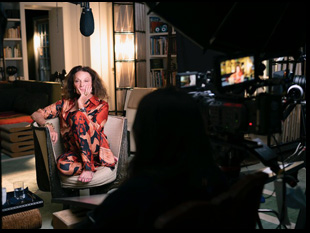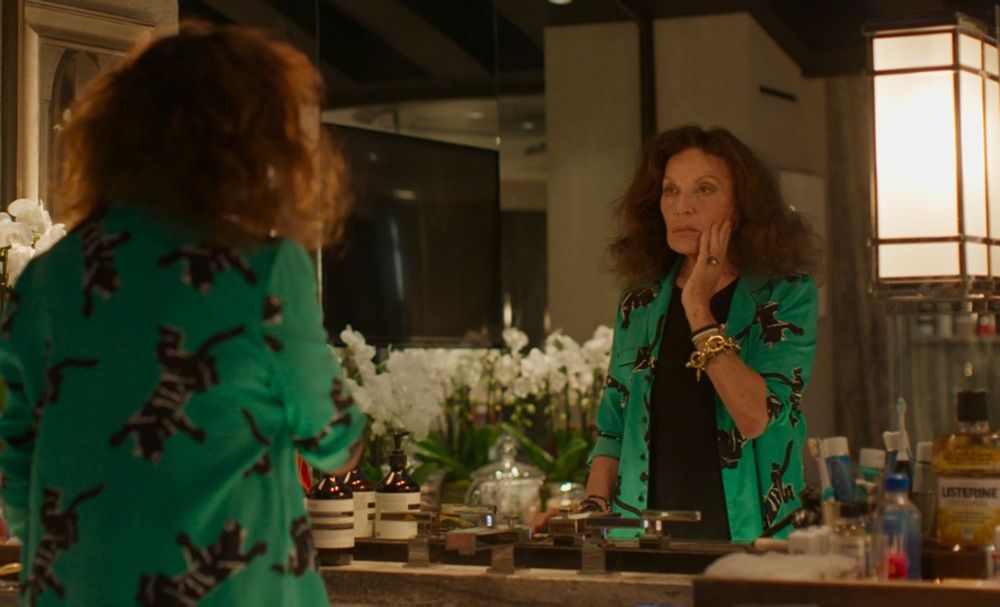“My vocation was to be a woman in charge and fashion was a way to do it,” Diane von Furstenberg confides to Sharmeen Obaid-Chinoy and Trish Dalton, giving the filmmakers not only a title for their exuberant biography of the self-made entrepreneur and fast fashion pioneer, but a raison d’être. Moving briskly to keep up with the 76-year-old who Karlie Kloss notes is one of the youngest people I know, “Diane von Furstenberg: Woman in Charge” shows that while von Furstenberg’s ingenious idea to create a wrap dress that was relatively inexpensive to make and easy to throw on for customers eager to look fashionable may be what she’s best known for, what may be less so is how she put herself in the position to seize the moment to make it into a mass market phenomenon and dressing women for success went well beyond the clothes she was making for them.
von Furstenberg’s personal life may add plenty of sizzle to the proceedings when she was once married to Prince Egon von Furstenberg and now partner to media mogul Barry Diller, with her kids Alexandre and Tatiana able to speak as frankly about her sex life in between as their mother when she’s proud to be an open book, but “Woman in Charge” finds things are even more fascinating when her professional life was never dull, either. Recalling how she grew a thick skin from her start answering the phone as an assistant to a photographer’s agent, shielding him from calls for people he hadn’t paid or one night stands he didn’t want to see again, to criss-crossing the country with samples she made from scraps of T-shirt fabric that she turned into dresses, building a groundswell of interest before grabbing the attention of key fashion world figures such as Diana Vreeland, von Furstenberg’s indefatigable spirit comes across even now, making the descriptions about how she navigated the peaks and valleys of a rough business secondary in understanding how she pulled through to the charm and persistence that are naturally part of the reflections.
Obaid-Chinoy and Dalton infuse that personality into every element of “Woman in Charge,” drawing upon the copious scrapbooks von Furstenberg has kept over the years with handwritten notes about times at Studio 54 or family memories dating back to growing up in Brussels as the daughter of a Holocaust survivor. Feeling sometimes like one of the casual dinner parties where she and Diller hold court now with the rich and powerful, there is no shortage of star power as everyone from Hillary Clinton and Gloria Steinem and Christian Louboutin and Marc Jacobs share memories and speak to von Furstenberg’s impact and as her dresses made during the 1970s make a resurgence, you realize she’s continued to shape the culture all this time, from making fashion accessible to using her fortune to take on the AIDS crisis and look towards creating opportunities globally for women through her organization Vital Voices. With the film now streaming on Hulu after opening Tribeca and stopping over at DC/DOX earlier this month, the co-directors spoke about getting their arms around such an eventful life and wily icon, following the example that von Furstenberg set in their own goals for the film and how they got such a candid figure even more so.

Sharmeen Obaid-Chinoy: My relationship with Diane actually started with the Glamour Woman of the Year Award in 2012, and more than a decade later when we came on to work on this film together. We wanted to tell her story because both Trish and I have told stories about women who have faced extraordinary circumstances and rose to the occasion in the face of adversity and charted their own path. Diane very much fits in that same vein of filmmaking and the characters we filmed before.
When we started making the film, we were very clear that we wanted to make the film about the woman before fashion, and the more we peeled the onion and got to the inner sanctum of Diane’s life, the more it made us realize how much of an anthem of freedom this film was at a time when women need to hear more anthems of freedom. They need to see this icon that they may look up to and think has led this wonderful life, which [could be construed as] an easy life. But we wanted women to stop for a second and realize that actually her life has had many pitfalls. She has fallen down, picked herself up, she started a business, then she went bankrupt. She got divorced, she was a single mother, her mother had a breakdown, and she took all of these things that came her way, and channeled them to find a way back.
Trish Dalton: Obviously she has a big public persona and she was one of the first influencers, as we say in the film, and I think we wanted to show the personal side of her that we can relate to, the real person behind the public persona.
You really get that from the striking shot that opens the film as she’s applying makeup by getting up as close to the mirror as possible by sitting in the sink. How did that moment come about?
Sharmeen Obaid-Chinoy: It was the morning that we had just gotten together to begin filming, and Diane said, “I’m just going to go and put on some makeup.” So we ran into the dressing room with her and got the camera to follow her. Throughout our filmmaking, Diane would take five minutes to get dressed, [saying] “Right, I’ll just be out” and she’d do her own hair and put on her makeup. And she got into this sink and she started putting on her own makeup. And I think that we wanted to open the film with one of Diane’s radical ideas. Even though aging shouldn’t be a radical idea in 2024, the fact that she says that the wrinkles on her face and the lines are the map of her life and the sum of her experiences is something we felt very strongly that women today need to hear.
With so many eras and areas to cover, this is really well-structured. Was it difficult to organize?
Trish Dalton: Yeah, the challenge for us is that she’s lived such a big life. She says she could have lived 300 years. There’s so many stories, we had to pick and choose where to lean into and which stories to bring to life. I think what it came down to is intercutting her personal life with her business life, and leaning into that to remember that as she was, as Sharmeen said, having these ups and downs like the rest of us. We chose places where we felt were the most significant to her, and that’s why for us, the story of her mother, the story of her daughter, the story of her grandchildren, was very significant to her, and we wanted that to be an important part of the story.
Sharmeen Obaid-Chinoy: Also, Diane has not always been the insider, and when we went back to Brussels with her, and we went to her high school, to her middle school, and she said, “I wanted to get out of Brussels because I was the only girl who had dark hair and everyone else had blonde hair and blue eyes,” you realize that Diane was once an outsider, and this is the story of her from the outside making it to the inside.
She says she doesn’t visit Brussels often because of the tragic memories it brings back, but she’s there for the occasion of this exhibit of her fashion. Was that something you knew was in the works or was it a stroke of luck?
Trish Dalton: That is something that we had already decided to film before that [exhibit] was set, but we wanted to include it because her going back to Brussels and the anniversary of the 50 years of the wrap dress was something that did make her feel reflective. We wanted that to be in it, but it just happened naturally while we were filming.
You discover she’s a great subject for a documentary when she keeps these voluminous scrapbooks. What was that like to uncover?
Trish Dalton: When we saw her scrapbooks, we thought, “Wow, this is a treasure trove.” It reflects the fact that she was somebody who did [so much]. She collected so many photos and documented so much of her life through her journals and her scrapbooks and her photography, and we wanted to bring that to life. She very much was into collage and how she works on her designs and her scrapbooks was a bit intertwined, so we wanted to bring that to life with animation and our graphic treatment.
Was there anything that hit the cutting room floor that you were sad to lose, given all the other ground you had to cover?
Shameen Obaid-Chinoy: Well, Vital Voices is an organization that she has been very closely connected to, and there are women in the Vital Voices network who work in very difficult circumstances in their countries to create spheres of influence and change things for women. We wish that we would have been able to spend more time in showing those connections, because in those relationships that Diane has invested her time and amplifying the voices of those women has helped those women in many of those countries.
Trish Dalton: Yeah, I hope that people will look at the work that she does with the DVF Awards and with Vital Voices and those stories can come to light after this documentary. Diane has touched so many people, especially women, and their stories about how she changed their lives was very inspiring and a huge part of what Diane’s work is. And [generally] this was a situation of she knows so many people and she’s touched so many people’s lives that we could not fit them all in. There were so many interesting people and interesting stories, that was a challenge, so it was more like how do we fit all of these in?
You manage to do justice, it seems like. What have these past two weeks been like with premieres at Tribeca and DC/Dox?
Sharmeen Obaid-Chinoy: We are excited to share this anthem of freedom, and on opening night at Tribeca, I think for both Trish and myself to sit in the audience and hear people reacting to what [Diane is] saying, whether it’s a sigh or whether it’s a laugh or people shedding tears when they hear the story of her mother’s breakdown, I think to be able to take audiences on this journey with Diane has been really a wonderful experience.
“Diane von Furstenberg: Woman in Charge” is now streaming on Hulu.




